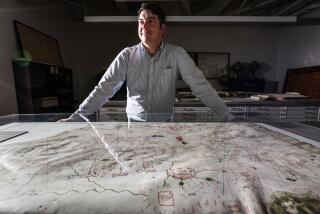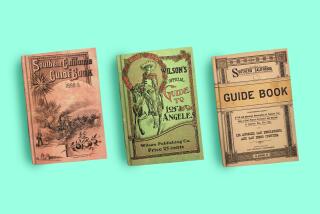Rand McNally to Broaden Thomas Bros.’ Horizons
- Share via
Thomas Bros. Maps, whose thick, detailed guidebooks have helped millions of Southern Californians navigate the region’s roadways for decades, is being acquired by global map maker Rand McNally & Co., the companies said Thursday.
Rand McNally is expected to push the privately held Irvine company into a more ambitious effort to develop high-tech tools to guide motorists.
Although Thomas Bros. has ventured into technology-driven products such as maps that can be viewed on computers, the venerable Thomas Guide still accounts for more than 85% of the company’s $27 million in annual sales.
More than 1 million Thomas Guides are sold each year in Los Angeles and Orange counties.
Rand McNally, the world’s largest maker of commercial maps, said both the Thomas Guide and the company’s work force of about 180 employees will remain intact.
Financial terms of the deal were not disclosed.
Warren B. Wilson, 77, who acquired Thomas Bros. in 1962 from the family of founder George Coupland Thomas, said Thursday was a bittersweet day for the company, one of the largest minority-owned firms in California.
“It’ll be very hard for me to leave it. Very hard,” he said after meeting with employees.
Wilson, who has four daughters and a son, said he plans to retire next year. He said he is selling the company partly because none of his offspring is interested in running it.
Rand McNally, which is based in Skokie, Ill., and has about 1,000 employees, produces commercial maps and atlases, among other products. It also is privately owned, and has annual sales of about $70 million.
Both companies are facing increasing competition in the arcane world of map making, and technology is playing a major role in that trend.
Computers are allowing “more people to make maps,” Wilson said. “But there are not many major companies that can publish Thomas Guides. That’s why Rand McNally bought us.”
Other big players in the industry include Etak Inc., which is owned by Rupert Murdoch’s News Corp., and Geographic Data Technology Inc. Both companies are making digital street maps of the entire United States.
Another challenge comes from improving global positioning systems, which use satellites to pinpoint a car’s location and provide a corresponding map on a small video screen, or verbal instructions from a computer.
These systems aren’t in widespread use in the United States but are a priority item for high-end auto makers.
While Thomas Bros. is particularly strong in local mapping products, both print and digital, Rand McNally is stronger in national and international products, which include TripMaker, a national travel planning software program. The company published its first national road atlas in 1924.
“Bringing Thomas Bros. and Rand McNally together is strategically a complimentary joining,” said Henry J. Feinberg, Rand McNally’s chief executive.
Thomas Bros. has excelled at integrating print and electronic products, Feinberg said. For example, Thomas Bros. offers a CD-ROM of Orange County with page and grid numbers that correspond with the printed Thomas Guide, he said.
Rand McNally doesn’t intend to change the Thomas Guides, except to expand into new regions with new capabilities, he said. He declined to elaborate.
In January, Thomas Bros. will unveil a Spanish version of its Los Angeles and Orange counties map books. Jim Welch, vice president of marketing, said books in other languages are a possibility.
Wilson, whose late brother Lionel Wilson was the first African American mayor of Oakland, is credited with pushing the company to expand and launch high-tech ventures.
He moved Thomas Bros. from Los Angeles to Irvine in 1980, spending $10 million to switch from manual cartography to computerized mapping.
The company also began to expand beyond California. It moved eastward for the first time in 1995 when it won a $2-million contract to develop a digital database of Washington, D.C., and neighboring counties in Maryland for the region’s real estate association.
Until recently, Wilson envisioned a city-by-city expansion along the East Coast, but getting established in the Washington area cost more than $1 million.
“It became apparent it was very expensive and put pressure on our cash flow,” he said. “We saw that, if we did that in Philadelphia, Boston and New York, we just didn’t have the financial resources for that kind of growth.”
There are now more than 60 editions of the Thomas Guide, primarily in the West’s major cities such as Seattle, Phoenix and Las Vegas.
Thomas Bros. was founded in Oakland in 1915. When road changes occurred in the early days, the company would send out workers to update existing maps, rather than drawing up new ones.
When Thomas Bros. moved to Los Angeles in the mid-1940s to take advantage of the area’s burgeoning growth, its signature guides were small enough to fit into a car’s glove compartment. The company also made maps to the homes of movie stars, including Mary Pickford and Gary Cooper.
The company devised its popular grid system in 1948, and later expanded it to the 8 1/2- by 11-inch format. The hefty combined Los Angeles/Orange County edition sells for $29.95.
Eventually, Thomas Bros. managed to “grid out” the entire state, including undeveloped areas. In the 1970s, the company began transferring hand-drawn manual maps to the digital format. The first digital guide was designed for Sacramento County in the early 1990s.
The company licenses its databases to government entities, and its Thomas Guide is a staple at government offices and private businesses throughout the state.
“They are pretty much in every one of our sheriff’s units,” said Hector Rivera, spokesman for the Orange County Sheriff’s Department. “The maps are invaluable.”
Wilson was Thomas Bros.’ attorney before buying the company.
More to Read
Inside the business of entertainment
The Wide Shot brings you news, analysis and insights on everything from streaming wars to production — and what it all means for the future.
You may occasionally receive promotional content from the Los Angeles Times.










